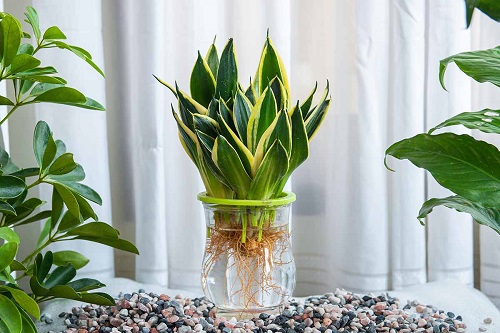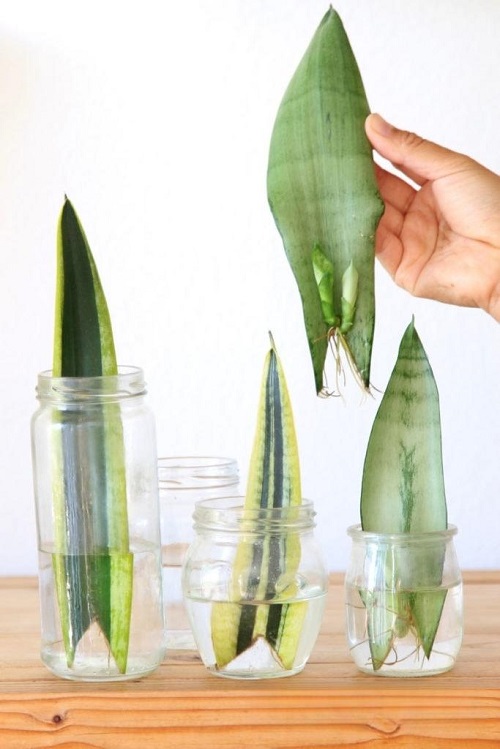Growing Snake Plants in Water is an easy way to multiply this air-purifying beauty, especially for busy gardeners!

Propagating a Snake Plant in Water might sound surprising, but it’s an easy way to expand your plant collection without the fuss of soil. If you are still wondering How to Grow Snake Plants in Water, here’s a step-by-step guide to help you out!
LEARN ABOUT GROWING POTHOS IN WATER HERE
Why Grow Snake Plants in Water?

Growing Snake Plants in Water has its own advantages that make it a more suitable option. Let’s learn how:
- Water-grown Snake Plants allow you to keep a close eye on the root health and growth. This visibility is helpful for new gardeners to observe the plant’s health and growth patterns that are usually hidden in soil.
- Snake Plants are already easy to care for, but hydroponics simplifies it further. Forget about soil issues like drainage or moisture checks; just change the water every few days, and you are good to go.
- Hydroponics gives you the option to precisely manage the nutrient intake of your Snake Plant. You can change the water anytime if you notice unhealthy growth or signs of nutrient bulidup—something that’s more challenging with soil-based growing.
- Plus, this process helps you to alter the pH level of the water according to the plant’s specific needs.
- In soil, root rot is a sneaky enemy, but in water, it’s a lesser concern. Here, the roots breathe easy with direct access to oxygen, keeping them healthy and free from fungal threats.
- Growing Snake Plants in Water give you the liberty to display it in creative ways, levelling up your aesthetics game.
How to Grow Snake Plants in Water?

Growing Snake Plants in Water is a rewarding experience if you do it correctly. Here’s a detailed guide for your help:
What You’ll Need:
- A healthy snake plant
- A sharp knife or pruning shears
- A glass jar or vase
- Clean water
Steps to Grow Snake Plant in Water:
#1: Select and Cut the Leaf
Start by choosing a mature, robust leaf from your Snake Plant, ensuring it’s healthy and undamaged. With a sharp knife or scissors, neatly slice it at the base. This clean cut will boost the chances of successful rooting in water.
#2: Arrange the Cutting in Water
Next, place your leaf cutting in a clear, narrow jar or vase. Fill it with water so that it covers about 15% of the leaf’s bottom. This will eliminate any chances of leaf rot, allow it to absorb water more efficiently and start rooting fast.
#3: Stabilize the Cutting
If the leaf tends to lean or wobble in the container, especially if it’s a bit narrow, use toothpicks to secure it. Carefully insert the toothpicks so the leaf stands upright, maintaining constant contact with the water for even root growth.
#4: Observe Root Development
You’ll have to wait patiently for one to two months to start seeing roots develop. Regularly monitor its growth, looking out for new roots sprouting, which signals a successful propagation.
#5: Go with an Alternative Approach—Pup Propagation
Snake Plant Propagation in Water can be a lot easier if you grow it via pups, as those that are already growing in soil might take a little longer time to root.
Separate a young pup from the parent plant and rinse its roots under running water to remove any soil particles and ensure a healthy start in water. Place the pup in a water-filled vase like, you’d do with a leaf cutting. As these offsets already have a rhizome, they easily adapt to water, leading to a quicker and more successful propagation.
After-Care Tips for Water-Grown Snake Plants

Once your Snake Plant’s roots have developed in water, it’s important to provide the right care to ensure it continues to thrive. Here’s how you can do that:
- Change the water every 5-7 days to keep it fresh and clear of algae or bacteria, which are no friends to your plant. For the purest care, use distilled or rainwater. If tap water is your go-to, let it sit overnight to allow the chlorine to evaporate.
- Direct sunlight can scorch the leaves, while insufficient light can impede growth. Place the plant near an east-facing window, where it can bask in 2-3 hours of morning sunlight. During peak summer, or on sunny days, drape a sheer curtain to provide enough light without the intensity of direct exposure.
- Your water-grown Snake Plant will flourish in temperatures between 50-95°F (10-35°C). However, it prefers to be in warmer conditions, ideally above 60°F (15°C). Keep the plant away from cold drafts and excessively hot areas to prevent stress.
- Regularly inspect the roots for signs of rot or decay. Healthy roots should be firm and white or pale yellow. If the roots start to overcrowd the container or look unhealthy, gently trim them with clean scissors.
- Use a balanced, water-soluble fertilizer for your Snake Plant. A teaspoon of fertilizer, diluted to 1/4th its strength every third or fourth water change is sufficient. If you have an aquarium, you can use its diluted water once in 5-6 weeks for an added boost.
GOT HOLES IN YOUR SNAKE PLANTS? LEARN POTENTIAL WAYS TO FIX THE PROBLEM HERE!
Best Snake Plants to Grow in Water

1. Golden Snake Plant (Sansevieria trifasciata ‘Laurentii’): Ideal for beginners, this variety boasts a robust root system and shows excellent tolerance to varying water conditions, significantly reducing the risk of root rot.
2. Moonshine (Sansevieria trifasciata ‘Moonshine’): The ‘Moonshine’ is particularly suited for water growth due to its beautiful silvery-gray foliage, offering a stunning visual contrast as the roots develop in water.
3. Cylindrical Snake Plant (Sansevieria cylindrica ): Its unique round, tall leaves make it a fascinating choice for water propagation, requiring a bit more attention but rewarding with its distinctive appearance.
4. Bird’s Nest Snake Plant (Sansevieria trifasciata ‘Hahnii’): Compact and nest-shaped, this variety is perfect for water growing, offering a close-up view of its leaf patterns and thriving well with regular water monitoring.






